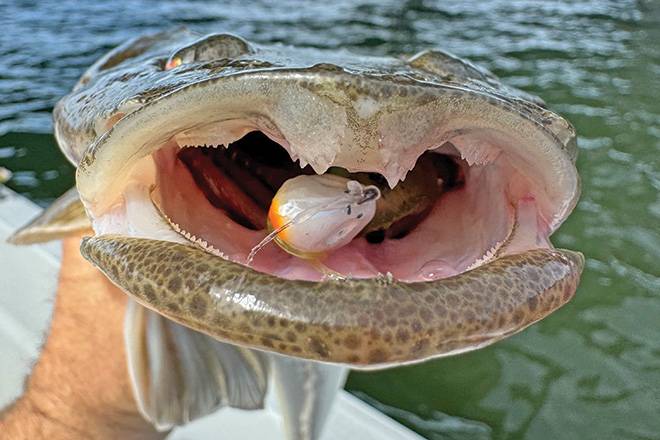It’s winter already!
Time flies when you’re having fun!
The past couple of months have produced some excellent catches around southeast Queensland.
The larger systems, such as the Pine and Caboolture rivers, have been on fire, especially around the mouths.
Flathead were the most common catches for those anglers fishing lures, with tailor and bream not far behind.
I’ve spent a lot of time chasing flatties recently and have been playing with a few different lures.

These days, anglers have a variety of soft plastics to choose from and it can be very daunting walking into a tackle shop for someone who hasn’t used lures before.
I recommend going into a specialised tackle shop instead of one of the bigger chains.
For example, Tackle World at Lawnton is an excellent shop for anglers who live on the north side of Brisbane.
The staff there actually fish and are happy to pass on information that will help you get connected to a few flatties.
Lure selection can make a huge difference to your catches on the day, particularly if the fish aren’t quite in the mood to feed.
To prepare for what the fish want on any given day, I always carry a variety of soft plastics.
When chasing flathead, I like to use either a paddle tail, curl tail or prawn imitation.

Soft vibes are also a good option, especially in deeper water.
This month, I won’t bother going into hard-bodies for flathead, yet they also have their place in my flatty arsenal, namely trolling.
When chasing flathead, I take at least two rods, so I’m not continually changing lures.
One will always have a prawn imitation on it and the other will start with a paddle tail.
I prefer paddle tails in the 3-4” size.
Flathead aren’t shy about eating a big plastic, and a lot of undersized fish will happily eat a 4” or larger sized plastic.

Smaller sized soft plastics still work very well, however on average, I find they attract smaller fish, including tiny undersized models.
Small flatties are always the ones that will spike you, so minimising the number of little rats that come aboard is a bonus!
Stacks of good paddle tails are available in a variety of great colours.
I stick to two or three brands and make sure I have a good selection of colours to cover all conditions.
Prawn imitations are excellent flathead lures.
The 92mm Pro Lure Clone Prawn is a great flatty catcher, chiefly when jigged through deeper water in the 3-9m range.
I have been playing around with Fish Craft Dr Prawn plastics in the 3” and 4” sizes lately and they’ve produced very well.

My son Luke has turned into a very dedicated young fisho and has hassled me to make some soft plastics with him for a few years now.
My friend Benny decided he’d had enough of making plastics and generously passed on a stack of gear for us to start pouring our own.
Mostly we’ve been using a 3” and 4” paddle tail mould that works nicely.
The fun part was mixing the colours, then going out to try them the following day.
Our first batch produced some interesting colours, to say the least.
Luke was very keen to try them out and picked the ugliest colour from the bunch.
To my surprise, he smashed a heap of fish on that colour and by the end of the session, it was held together with super glue.
We ended up catching over 30 flathead in a few hours that morning, so the young angler was very happy.
When chasing flathead, jig head selection is very important.
For Brisbane, the water I chase flatties in can vary between .5-15m in depth, so I carry a wide range of jig heads.
Sharp good quality hooks will get you a lot more hook-ups.

Choosing cheap hooks is not a good option.
This an area where you don’t want to go for the cheaper brands.
Hooks that aren’t chemically sharpened miss a lot of fish.
Flathead can be very aggressive feeders and they will happily chase a plastic at high speeds when they’re feeding.
I prefer to use a heavier jig head than most anglers would choose, so I can fish it a bit faster.
The lightest I use is 1/4oz, even on the flats in very shallow water.
Occasionally, I find myself using a 3/8oz jig head in only a 1m of water.
When the fish are feeding aggressively, they aren’t very fussy.
However, on days when they’re shut down, it can be quite a different story.
Working soft plastics very slowly is a little boring, but if it means catching fish or not, it’s obviously worth doing.
I’ve had days when I’ve had to dead stick the lure on the bottom for 5-10 seconds to get a bite.
Deadsticking is a super boring technique.
It involves sinking the plastic to the bottom and leaving it to sit still.
Using this technique, you often won’t even feel a bite, then when you go to move the lure, you’ll come up tight to a flatty.
Flathead should continue to feed well this month, so hopefully the rain stays away.
See you on the water.
 Bush ‘n Beach Fishing Magazine Location reports & tips for fishing, boating, camping, kayaking, 4WDing in Queensland and Northern NSW
Bush ‘n Beach Fishing Magazine Location reports & tips for fishing, boating, camping, kayaking, 4WDing in Queensland and Northern NSW









